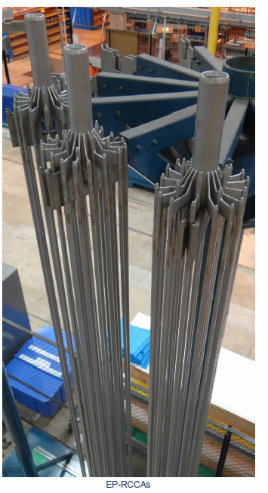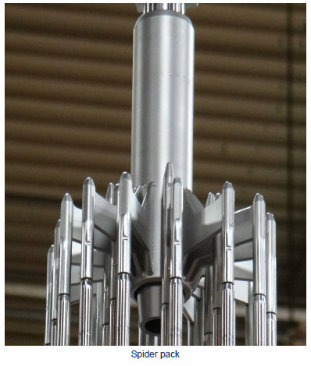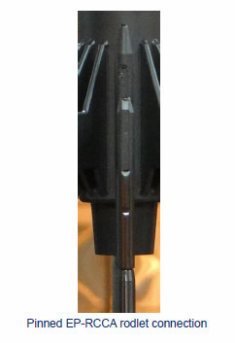Background
The enhanced performance rod cluster control assembly (EP-RCCA™) was developed to provide enhanced performance relative to previous control rod designs through the selection of materials and surface treatment that enhance the product’s resistance to wear and irradiation. The materials were selected with the intent to perform well with regard to corrosion and dimensional stability over the EP-RCCA design lifetime.
The EP-RCCA design is the direct result of applying Westinghouse knowledge of the reactor system and functional relationships between RCCAs and the system as a whole, providing an integrated solution that is fully compatible with the reactor, and in particular, the internals and the fuel assemblies.
Description
Westinghouse EP-RCCAs include three features for extended service performance:
- High-purity austenitic stainless-steel cladding
- Increased diametral clearance between the lower absorber and the cladding inside diameter
- Hard-chrome plating on the surface of the rodlets
The control of certain chemical impurities in EP-RCCA rodlets is important to the rodlet’s corrosion resistance and reduction in susceptibility to irradiation-assisted stress corrosion cracking (IASCC).
A small increase in the gap between the silver- indium-cadmium (Ag-In-Cd) absorber and the inside surface of the rodlet is incorporated in EP-RCCAs to accommodate tip swelling of the absorber, thus mitigating absorber-induced strain to the cladding.
EP-RCCA rodlets are manufactured with stainless- steel cladding that is hard-chrome plated on the outer surface to increase EP-RCCA wear resistance.
EP-RCCAs are available for purchase in all Westinghouse nuclear steam supply system (NSSS) core configurations (14x14, 15x15, 16x16, 17x17, and 17x17XL).
The EP-RCCA consists of enhanced performance absorber rodlets, which are attached to a spider pack that consists of a brazed spider assembly, spider springs, spring retainer and spring tension bolt.
The rodlet absorber material is Ag-In-Cd alloy in the form of an extruded rod. A small diametral gap is provided between the absorber material and the cladding to accommodate relative thermal expansion, to allow for irradiation-induced swelling, and to facilitate fabrication. The lower section of the absorber rod is subjected to much higher neutron fluence in operation relative to the rest of the absorber material, so additional diametral clearance has been introduced in thisregion to accommodate the anticipated additional swelling.
The absorber rod cladding material is high-purity, partially cold-worked, Type 304 stainless steel tubing, which is resistant to IASCC. Industrial hard- chrome plating is applied to the surface of the tubing to enhance its wear resistance. The chrome plating is applied over the length of the rodlet that is in contact with the upper internals guide surfaces during operation.
The EP-RCCA rodlet is screwed into the spider finger. It is locked in place by drilling a hole through the finger into the rodlet connector, and then a pin is inserted and welded in place. Geometric tolerancing of the pins and pin hole, plus inspection of pin welds, is performed so that the pins are properly seated, engaged, and captured
The absorber rod cladding material is high-purity, partially cold-worked, Type 304 stainless steel tubing, which is resistant to IASCC. Industrial hard- chrome plating is applied to the surface of the tubing to enhance its wear resistance. The chrome plating is applied over the length of the rodlet that is in contact with the upper internals guide surfaces during operation.
The EP-RCCA rodlet is screwed into the spider finger. It is locked in place by drilling a hole through the finger into the rodlet connector, and then a pin is inserted and welded in place. Geometric tolerancing of the pins and pin hole, plus inspection of pin welds, is performed so that the pins are properly seated, engaged, and captured.
Experience
Westinghouse has been delivering the EP-RCCA design since 1987. The EP-RCCAs have been used by more than 25 customers worldwide in over 70 plants and have demonstrated a proven track record of excellent performance.
Over 3,000 EP-RCCAs of a wide variety of designs (14x14, 15x15, 16x16, and 17x17) are currently in operation. Westinghouse is actively monitoring current EP-RCCA operational performance data. In addition, irradiated RCCAs have been inspected, and rod drop tests have been performed to demonstrate the continued high performance of the EP-RCCAs.
More recently, efforts have begun to analyze EP-RCCA expected service life during flexible power operations (FPO), depending on the operational needs of utilities on a plant-specific basis.
EP-RCCA are trademarks or registered trademarks of Westinghouse Electric Company LLC, its affiliates and/ or its subsidiaries in the United States and may be registered in other countries throughout the world. All rights reserved. Unauthorized use is strictly prohibited. Other names may be trademarks of their respective owners.




